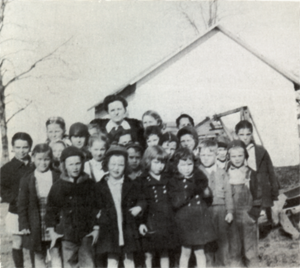
Selling the One-Room School
The old school house, sitting just east of the brick school, had been used for meetings and on Sundays it served as a church. It again was used as a school (along with another building) about 1908 when the district had so many students the brick school could not hold them all. The situation had changed by 1917, and the school board decided to sell the old building. The Ladies Aide wanted to buy the building and make it available for meetings and Sunday services. They began raising money to purchase the old school and planned to move it across the road into the cemetery. However, someone else had the idea that the old school would make a good chicken coop.
The day of the auction, June 2, 1917, it was well known who was going to bid for the building. Everyone also knew how much money the Ladies Aide had. The first bid came from the Aide. They bid their total amount available. Knowing that the ladies had no more money, the person who wanted a chicken coop bid higher. This caused Charles Peterson, a school board member, to become upset. He offered to loan the Ladies Aide whatever money they needed to acquire the building. The Aide won the bidding, paying $190 for the old school, and they moved it to the cemetery.
Despite the lack of school funds, Pleasant Hill residents still seemed to value education. Since students could only attend Pleasant Hill school through the eighth grade, the school district began sending students to Des Moines for further education. The school district would pay $12 per month in tuition to Des Moines and the students' parents had to pay $3 per month. Students were expected to find their own transportation to East High School. For most of them, this meant walking to East Dean and 33rd Street to catch the trolley.
High Taxes
The cost of paying tuition for students to go to high school as well as run the elementary school, coupled with the small area of land the district relied upon for its tax base meant the people paid high taxes. Some years the taxes were over $100 per thousand dollars of property valuation. The burden was so great the people tried to correct it.
About 1926, the three school directors, including Alvin Peterson, and farmers who paid the high taxes went before the state legislature to seek aid. They asked the legislature to force the Des Moines district to take in Pleasant Hill. This would have reduced the tax mileage rate from 82 mills to 60 mills that Des Moines was paying at the time. A bill was introduced in the legislature, but it failed to get out of committee.
Shortly before this, around 1922, Lower Agency started to send its students to Pleasant Hill. Lower Agency, the district south of Pleasant Hill, had had a school building but lost it when the
